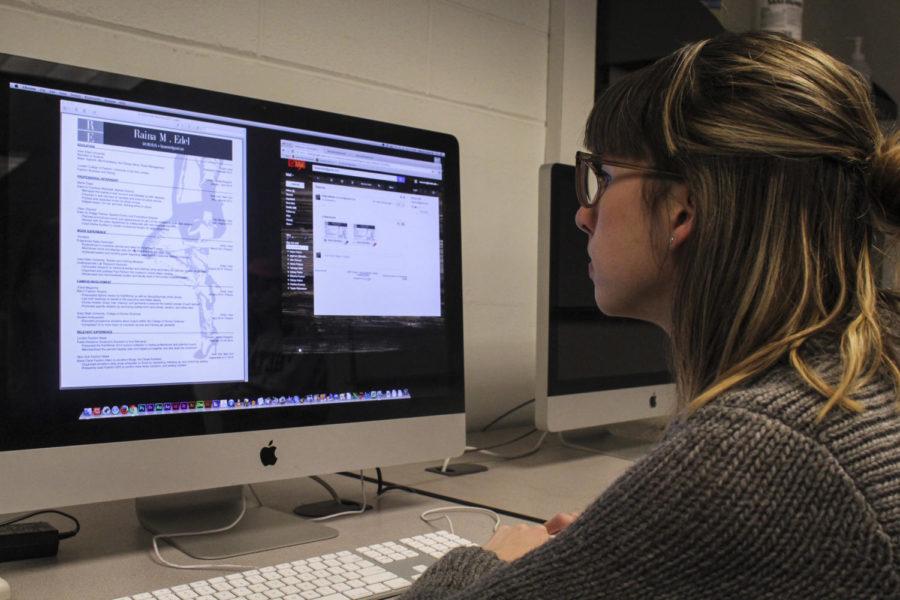Creating an apparel résumé
Kelby Wingert/Iowa State Daily
Eileen Moores, senior in apparel, merchandising and design, creates résumés for ISU students. Moores adds stylish flair to résumés to make them stand out.
February 3, 2015
From a college internship to a professional career, résumés are critical to success in the interview process. In any industry, résumés are a key component in getting internships and obtaining a job after graduation.
When it comes to résumés in the apparel program, there are many key details that create a top-notch résumé. Apparel adviser Ann Thye teaches the AESHM 311 class, which goes into extensive detail on how to build a quality résumé. In this class, apparel students learn how to construct a résumé and cover letter to appeal to industry professionals.
Apparel adviser Christine Wise also helps students on a daily basis create quality résumés and help students feel confident in their abilities and how their skills and past experiences are reflected on paper.
Prior to taking ASEHM 311, apparel students take AESHM 113, a class where each student learns the basics of resume building and creation. After completing 311 and their required apparel, merchandising and design internship, students follow up and take AESHM 411. In each of these classes, students improve their résumés. It is important to improve and continue to update a résumé.
There are many key components that apparel students must include in their résumés.
Thye said that it is key to start gaining experiences in the apparel industry as early as possible.
One way students can do this is by working in a retail position or joining student organizations on campus that relate to their specific major, whether it be an organization like Trend Magazine, working for the theater department creating costumes or helping out local boutique owners to learn about entrepreneurship.
Eileen Moores, senior in apparel, merchandising and design, creates résumés for students at Iowa State. Using Adobe Photoshop and other programs, she creates custom résumés that feature subtle touches of color and pattern to reflect the student’s personal style.
Moores said she also believes that experience is key on one’s résumé.
“I believe that playing up experience is the most important factor on a résumé,” Moores said. “Even if you have not had the opportunity to have an internship yet, make sure you list leadership experience.”
Employers in the apparel industry are not only looking for prior internships, but also campus leadership experience relating to a major.
“They look for people who they can tell have good communication skills and have excellent attention to detail,” Thye said.
Showing past experiences on a résumé can provide a competitive edge in an application process. Make sure to be able to explain each experience, what you learned and how you can apply that to the specific opportunity.
“Show the employer what experiences, skills and knowledge you can bring to the internship,” Wise said.
In addition to experience, including GPA on a résumé is imperative in the apparel industry.
“Companies in our industry like to see GPA listed if it is 3.0 or above,” Thye said.
Another component to an apparel student’s resume is the design and color scheme.
“Because we are in a creative industry, more color and graphic design can be used than in some other areas of business,” Thye said.
Although apparel students have more creative freedom when it comes to design, there is a fine line between being professional and overpowering.
“Subtle colors or accent colors on section headings in your letterhead can be very attractive,” Thye said.
Be sure to not let your design take away from the content. A student’s experiences and skills take precedence.
By adding color, students can create a brand image for themselves. Adding subtle hints of colors can catch a recruiter’s eye in a good way. However, using bright colored paper or loud patterns can have a negative effect on a résumé.
“I’d stick to one to three different colors in a résumé,” Moores said, “Too much color can take away from the actual content you want the employers to look at.”
Thye stressed the importance of students building a brand image.
“You build your own brand image every day by how you spend your time,” Thye said. “A résumé is the place where you put that all together on one page to promote yourself for an internship that will be a springboard to your career.”
Making smart choices when deciding activities to pursue is important. Any activity that may further a student’s career choice is helpful and something appropriate for a résumé.
“The student who makes ‘purposeful choices’ in having their major, minor, study abroad experience, internship, work experience, skill development, activities and leadership position relate to their career objective creates a unique brand image,” Wise said.
Students must constantly add new positions or organizations to their résumés as they are gained. Also, be sure to keep the GPA updated as each semester passes.
In addition, it is important to create a different résumé for each position a student may apply for. This way, students can tailor the information on the résumé to that given company or position.
If one is seeking help on building the perfect résumé for the apparel industry, there are many resources to take advantage of.
First, be sure to take the AESHM 113, 311, and 411 classes. These are great for learning how to put together a résumé for the apparel industry, as well as getting corrections to previously created résumés. For additional help, students can make an appointment with Thye or other apparel, merchandising and design advisers. For general questions, the College of Human Sciences Career Services Office is a great resource.
“Apparel, merchandising and design students have the luxury of using their advisers to proof read résumés, in addition to the College of Human Sciences Career Services Office,” Wise said.







